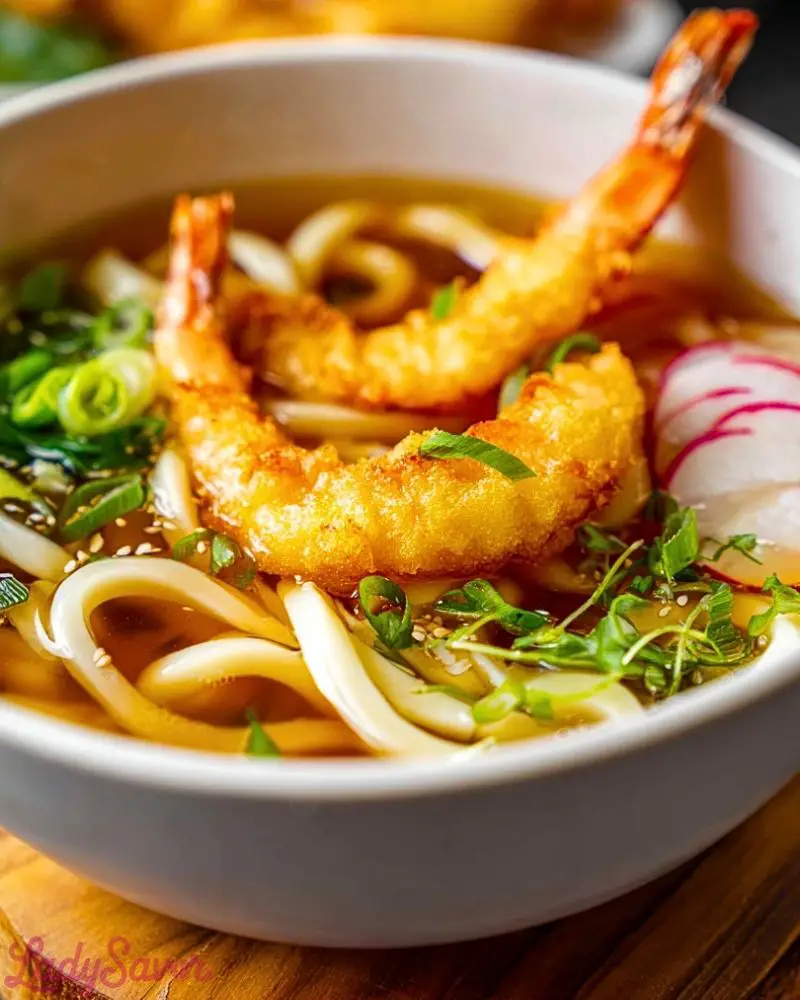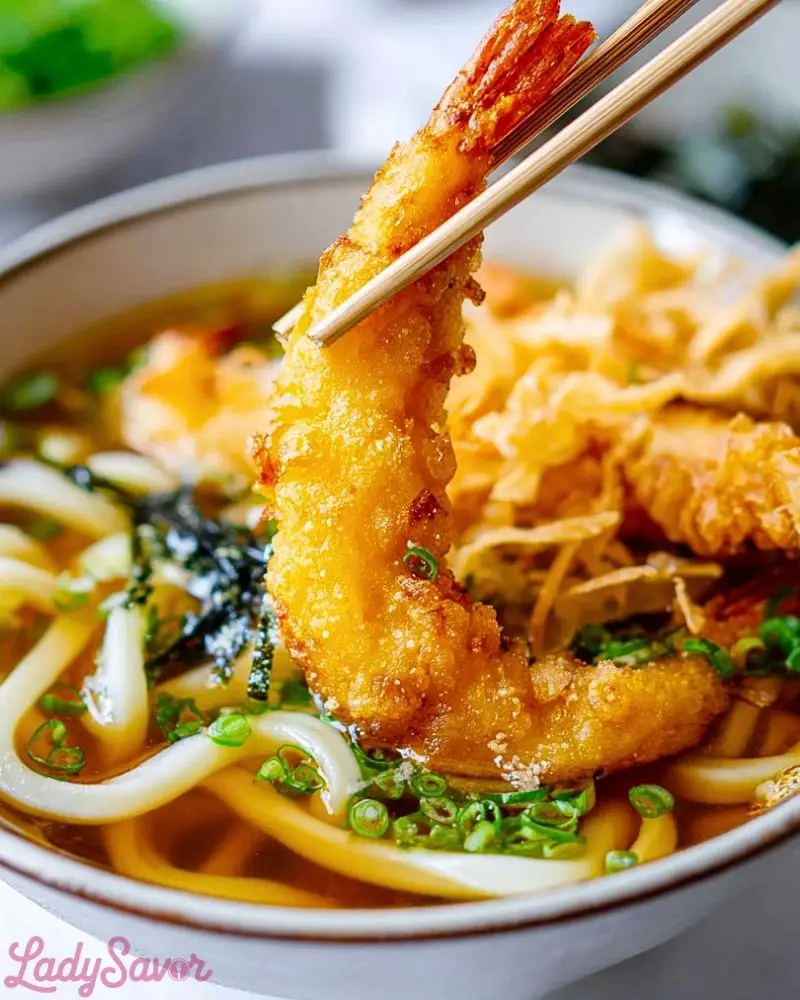There’s something incredibly comforting about a warm bowl of udon soup, and when you top it with crispy golden shrimp tempura, it becomes pure magic. The silky, chewy noodles soaked in a deeply savory dashi broth paired with that satisfying crunch of battered shrimp—it’s the kind of meal that makes me slow down and savor every bite. I remember the first time I had shrimp tempura udon at a small Japanese diner, and it was love at first slurp. Since then, I’ve been recreating it at home, fine-tuning the balance of textures and flavors until it became my go-to cozy indulgence.

What I love most about this Shrimp Tempura Udon Soup is how it feels like a complete dish all on its own. The umami-rich broth, the hearty noodles, the pop of fresh scallions and radish, and the crisp, juicy shrimp come together in perfect harmony. It’s not just a bowl of soup—it’s a full experience, especially satisfying on a cold day or when I want to impress someone with something special yet simple.
Why You’ll Love This Shrimp Tempura Udon Soup
This dish brings together the best of Japanese comfort food in one bowl. Whether it’s the crispy shrimp tempura sitting on top or the slurp-worthy udon noodles soaking in a flavorful broth, each spoonful is a mix of texture and taste. It’s satisfying without being heavy, customizable depending on what you have in the kitchen, and surprisingly easy to put together. Plus, it looks impressive—like something out of a restaurant—but is totally doable at home.
What Kind of Udon Noodles Should I Use?
When it comes to udon, freshness makes a difference. I usually go for fresh or frozen udon noodles from an Asian market—they’re thick, chewy, and ready in minutes. Frozen udon holds its texture the best and doesn’t become mushy in the broth. If you’re in a pinch, shelf-stable udon works too, just be sure not to overcook them. Avoid dried udon if possible; it tends to be thinner and lacks that signature bouncy bite that makes this dish so comforting.
Options for Substitutions
Shrimp tempura udon is versatile, and I love how easily you can tailor it to your taste or pantry:
- Shrimp: If you don’t eat seafood, try vegetable tempura using sweet potato, zucchini, or mushrooms. Chicken katsu is another delicious alternative.
- Broth: A traditional dashi base is ideal, but you can swap in chicken or vegetable broth in a pinch. Add a splash of soy sauce and mirin to get close to the original flavor.
- Udon noodles: Substitute with ramen or soba if that’s what you have on hand. The texture will change slightly, but it’ll still be delicious.
- Toppings: Don’t have radishes or scallions? Try baby spinach, bok choy, or a soft-boiled egg for extra richness.
- Gluten-free: Use gluten-free soy sauce and rice-based noodles, and coat the shrimp in cornstarch or gluten-free flour for the tempura.
Ingredients for This Shrimp Tempura Udon Soup
- Udon noodles: These thick, chewy noodles are the heart of the dish, absorbing the flavorful broth and giving the soup its comforting texture.
- Shrimp (large, peeled and deveined with tails on): The star of the tempura topping—sweet, juicy, and perfect for crisp frying.
- All-purpose flour: Used in the tempura batter to create that light, crisp coating on the shrimp.
- Cornstarch: Helps make the batter extra airy and crunchy when fried.
- Ice-cold water: Essential for making a light tempura batter—keeps the coating delicate and crisp.
- Egg: Adds richness and binding power to the tempura batter.
- Dashi stock: The soul of the broth—savory, slightly smoky, and full of umami.
- Soy sauce: Adds saltiness and depth to the broth.
- Mirin: Brings sweetness and balance to the savory flavors of the soup.
- Scallions: Fresh, aromatic, and slightly sharp, they brighten each bite.
- Radishes: Thinly sliced for a pop of color and crisp texture.
- Vegetable oil: Used for frying the tempura until perfectly golden and crunchy.

Step 1: Prepare the Broth
In a saucepan, bring dashi stock to a gentle simmer. Stir in soy sauce and mirin, adjusting to taste. Let it cook on low heat while you prepare the other elements—this allows the flavors to meld beautifully.
Step 2: Cook the Udon Noodles
Boil the udon noodles according to the package instructions. If using frozen noodles, they usually only need a few minutes. Drain and rinse under warm water to remove excess starch and set aside.
Step 3: Make the Tempura Batter
In a bowl, whisk together ice-cold water and egg until combined. Add a mix of all-purpose flour and cornstarch, stirring just until loosely blended. Don’t overmix; a few lumps are fine and actually help create that signature craggy tempura texture.
Step 4: Fry the Shrimp
Heat vegetable oil in a deep pan to 350°F (175°C). Dip each shrimp into the batter and gently lower into the hot oil. Fry in batches for 2–3 minutes until golden and crisp. Transfer to a wire rack or paper towels to drain.
Step 5: Assemble the Bowl
Divide the cooked udon noodles into serving bowls. Ladle the hot broth over the noodles. Top with crispy shrimp tempura, sliced radishes, and chopped scallions. Serve immediately while the shrimp is still crunchy.
How Long to Cook the Shrimp Tempura Udon Soup
The entire dish comes together in about 30 minutes. Here’s a breakdown:
- Broth: Simmer for 10–15 minutes to deepen the flavor.
- Udon noodles: Usually take 3–5 minutes if frozen or fresh.
- Shrimp tempura: Fry for just 2–3 minutes per batch.
- Assembly: Just a few minutes to bring everything together while it’s still hot and fresh.
It’s fast enough for a weeknight, but the final bowl looks and tastes like something from a high-end Japanese restaurant.
Tips for Perfect Shrimp Tempura Udon Soup
- Keep the batter ice-cold: Cold batter meeting hot oil is the secret to crispy tempura. Add a couple of ice cubes if needed.
- Use fresh oil for frying: It helps keep the shrimp golden and crisp rather than greasy.
- Don’t overcrowd the pan: Fry the shrimp in small batches to avoid lowering the oil temperature.
- Serve immediately: Tempura loses its crunch quickly in broth, so assemble the bowls just before serving.
- Garnish just before serving: Add scallions and radishes at the end to keep them fresh and vibrant.
Watch Out for These Mistakes While Cooking
- Overmixing the batter: A smooth tempura batter isn’t the goal. A few lumps are good—they lead to a crisper texture.
- Using warm water in the batter: Always use ice-cold water. Warm or room-temperature water creates heavy, oily batter.
- Frying at the wrong temperature: If the oil isn’t hot enough, the tempura will absorb too much oil. Use a thermometer or test with a small drop of batter.
- Letting the tempura sit too long: Tempura is best when freshly fried. Letting it sit even a few minutes can make it soggy.
- Adding shrimp directly to the broth: Always place the shrimp on top right before serving so they keep their crunch.
- Neglecting the broth: Don’t just pour in soy sauce and call it a day—balance it with mirin and good-quality dashi for depth of flavor.
What to Serve With Shrimp Tempura Udon Soup?
Pickled Vegetables
A side of Japanese pickles (tsukemono) adds a crisp, tangy contrast that cuts through the richness of the tempura.
Seaweed Salad
Light and refreshing, this brings a nice briny balance to the deep flavors of the soup.
Edamame
Lightly salted and steamed, these protein-packed pods make a great appetizer or side.
Gyoza (Dumplings)
Pan-fried dumplings filled with pork or vegetables are a hearty, savory addition to the meal.
Tamago (Japanese Sweet Omelet)
Sliced and served cold or warm, it offers a sweet-savory bite that pairs well with the broth.
Steamed Rice
Simple white rice balances the richness and rounds out the meal, especially if you’re extra hungry.
Japanese Cucumber Salad
A cool, vinegary cucumber salad brings a refreshing crunch and helps cleanse the palate.
Storage Instructions
Shrimp Tempura Udon Soup is best enjoyed fresh, but if you have leftovers, here’s how to store them properly:
- Udon noodles: Store separately from the broth in an airtight container in the fridge for up to 3 days. Reheat by dipping briefly in hot water.
- Broth: Keeps well in the refrigerator for up to 4 days or freeze it for up to 2 months. Reheat gently on the stove.
- Tempura shrimp: Unfortunately, it doesn’t stay crispy. Store in a paper towel-lined container in the fridge for up to 2 days, then re-crisp in a toaster oven or air fryer before serving. Don’t store it in the broth.
To reassemble, reheat the broth and noodles separately, then add fresh toppings and re-crisped tempura just before serving.
Estimated Nutrition
Per serving (based on 2 servings total):
- Calories: ~540
- Protein: 26g
- Fat: 20g
- Saturated Fat: 3g
- Cholesterol: 145mg
- Carbohydrates: 60g
- Fiber: 3g
- Sugar: 4g
- Sodium: 1050mg
These values are approximate and will vary based on ingredient brands and portion sizes, especially with frying oil absorption.
Frequently Asked Questions
Can I make the tempura batter ahead of time?
It’s best to make the batter just before frying. The cold temperature and freshly mixed ingredients are key to that light, crispy texture.
What’s the best oil for frying tempura?
Neutral oils like vegetable, canola, or peanut oil are ideal. They have a high smoke point and won’t overpower the flavor of the shrimp.
Can I use pre-cooked shrimp?
It’s not recommended. Tempura needs raw shrimp so it cooks just right during frying and doesn’t get rubbery.
Is it okay to use store-bought dashi?
Absolutely! While homemade is wonderful, high-quality instant dashi powders or concentrates make the recipe much quicker without sacrificing much flavor.
How do I keep tempura crispy?
Drain on a wire rack, not paper towels, and avoid covering it. Serve immediately, and keep it out of the broth until ready to eat.
Can I make this dish gluten-free?
Yes—use gluten-free flour and cornstarch for the batter, gluten-free soy sauce, and rice noodles or certified gluten-free udon.
What’s the difference between soba and udon?
Udon is thick and chewy, made from wheat flour. Soba is thinner, made from buckwheat, and has a nuttier flavor. Both are delicious, but udon is ideal for this dish.
Is shrimp tempura udon spicy?
Not at all. But you can add a touch of spice with chili oil, togarashi, or sliced fresh chili if you like some heat.
Conclusion
Shrimp Tempura Udon Soup is one of those dishes that combines elegance and comfort in a single bowl. It’s cozy yet refined, quick enough for a weeknight but impressive enough for guests. The contrast of silky noodles, savory broth, and crispy shrimp is pure delight—and with a few tweaks, you can make it your own. Once you try making it at home, you’ll realize just how satisfying and achievable this beloved Japanese classic can be.

Shrimp Tempura Udon Soup
- Total Time: 30 minutes
- Yield: 2 servings 1x
Description
A warm, comforting Japanese noodle soup featuring chewy udon noodles, savory dashi broth, and crispy golden shrimp tempura. Perfect for chilly evenings or when you’re craving something special yet easy to make.
Ingredients
2 servings udon noodles
8 large shrimp, peeled and deveined with tails on
1/2 cup all-purpose flour
1/4 cup cornstarch
1/2 cup ice-cold water
1 egg
3 cups dashi stock
2 tablespoons soy sauce
1 tablespoon mirin
2 scallions, chopped
4 radishes, thinly sliced
2 cups vegetable oil for frying
Instructions
1. Bring dashi stock to a gentle simmer in a saucepan. Stir in soy sauce and mirin. Let it simmer while you prep other elements.
2. Cook the udon noodles according to package instructions. Drain, rinse, and set aside.
3. In a bowl, whisk together ice-cold water and egg. Add flour and cornstarch, stirring lightly. Don’t overmix.
4. Heat oil in a deep pan to 350°F (175°C). Dip shrimp in batter and fry in batches for 2–3 minutes until golden. Drain on a rack.
5. Divide cooked noodles into bowls. Ladle hot broth over them.
6. Top each bowl with crispy shrimp, radishes, and scallions.
7. Serve immediately to enjoy the crunch of the tempura.
Notes
To keep tempura crispy, serve it immediately and avoid placing it in the broth until serving.
Use fresh or frozen udon for best texture.
Customize the broth with extra toppings like a soft-boiled egg or baby spinach.
- Prep Time: 15 minutes
- Cook Time: 15 minutes
- Category: Main Dish
- Method: Stovetop, Deep Frying
- Cuisine: Japanese
Nutrition
- Serving Size: 1 bowl
- Calories: 540
- Sugar: 4g
- Sodium: 1050mg
- Fat: 20g
- Saturated Fat: 3g
- Unsaturated Fat: 14g
- Trans Fat: 0g
- Carbohydrates: 60g
- Fiber: 3g
- Protein: 26g
- Cholesterol: 145mg
Keywords: udon, shrimp, tempura, noodle soup

